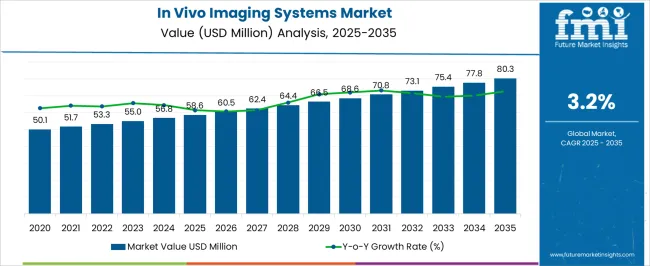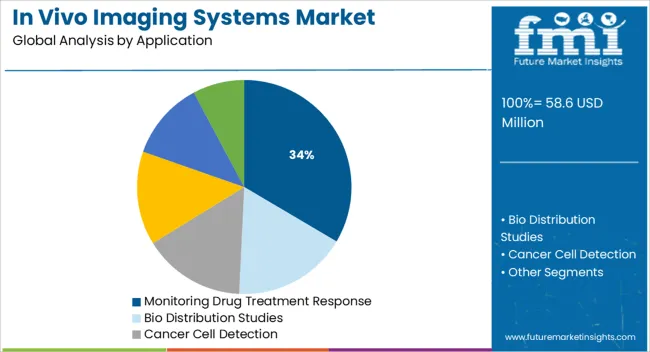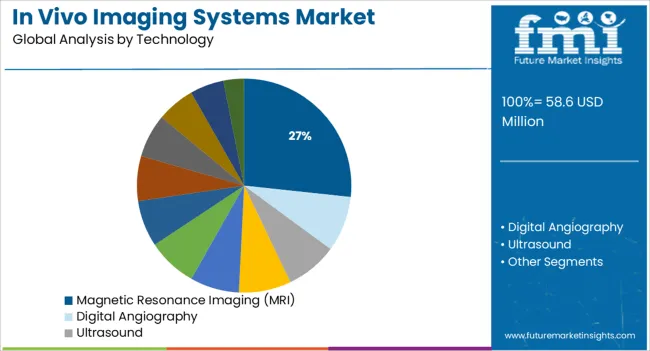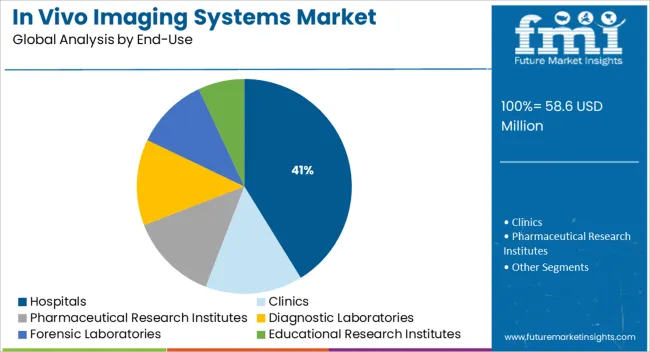The In Vivo Imaging Systems Market is estimated to be valued at USD 58.6 million in 2025 and is projected to reach USD 80.3 million by 2035, registering a compound annual growth rate (CAGR) of 3.2% over the forecast period.

| Metric | Value |
|---|---|
| In Vivo Imaging Systems Market Estimated Value in (2025 E) | USD 58.6 million |
| In Vivo Imaging Systems Market Forecast Value in (2035 F) | USD 80.3 million |
| Forecast CAGR (2025 to 2035) | 3.2% |
The in vivo imaging systems market is experiencing steady advancement due to rising demand for real time visualization of biological processes and disease progression in living organisms. The increasing emphasis on personalized medicine and the need for precise drug evaluation are driving demand for advanced imaging modalities that deliver high resolution and non invasive analysis.
Technological improvements in image fusion, contrast agents, and functional imaging have expanded the application scope across oncology, neurology, and cardiovascular research. Greater investments in preclinical and translational research, coupled with supportive regulatory environments, are promoting widespread adoption of imaging systems in both clinical and academic settings.
The growing need for accurate biomarker tracking and therapeutic efficacy assessment is expected to sustain market growth, especially as healthcare systems move toward evidence based approaches in treatment planning and monitoring.
The market is segmented by Application, Technology, and End-Use and region. By Application, the market is divided into Monitoring Drug Treatment Response, Bio Distribution Studies, Cancer Cell Detection, Biomarkers, Longitudinal Studies, and Epigenetics. In terms of Technology, the market is classified into Magnetic Resonance Imaging (MRI), Digital Angiography, Ultrasound, Nuclear Imaging, Positron Emission Tomography (PET), Single Photon Emission Computerized Tomography (SPECT), Optical Imaging (OI), Bioluminescence Imaging, Cerenkov Luminescence Imaging, Others, Ultrasound Imaging, and Computerized Tomography (CT). Based on End-Use, the market is segmented into Hospitals, Clinics, Pharmaceutical Research Institutes, Diagnostic Laboratories, Forensic Laboratories, and Educational Research Institutes. Regionally, the market is classified into North America, Latin America, Western Europe, Eastern Europe, Balkan & Baltic Countries, Russia & Belarus, Central Asia, East Asia, South Asia & Pacific, and the Middle East & Africa.

The monitoring drug treatment response segment is expected to contribute 33.50% of total market revenue by 2025 under the application category, making it the leading segment. This growth is attributed to the increasing need for dynamic evaluation of therapeutic interventions in real time.
In vivo imaging systems enable visualization of treatment impact at the cellular and molecular levels, which is critical for drug development, clinical trials, and personalized medicine approaches. Their ability to provide longitudinal data from the same subject reduces variability and improves study efficiency.
This application supports rapid decision making in therapy adjustment and is widely adopted across pharmaceutical companies and research institutions. As treatment efficacy monitoring becomes central to precision healthcare, this segment continues to lead due to its strategic role in improving patient outcomes and optimizing therapeutic strategies.

The magnetic resonance imaging segment is projected to account for 26.70% of total revenue by 2025 within the technology category. This dominance is driven by its capability to deliver high contrast images without ionizing radiation, making it ideal for repeated imaging in both clinical and research settings.
MRI provides detailed anatomical and functional information which is essential for early diagnosis, tumor tracking, and brain imaging. It is especially valued for its superior soft tissue resolution and ability to assess physiological processes non invasively.
With ongoing advancements in imaging speed, hardware miniaturization, and contrast agent development, MRI continues to be widely utilized in preclinical and in vivo research. Its non invasive nature and accuracy reinforce its role as a leading technology within the market.

The hospitals segment is expected to hold 41.20% of total market revenue by 2025 under the end use category, making it the most dominant segment. This is due to the increasing integration of in vivo imaging systems into clinical workflows for diagnosis, treatment planning, and follow up.
Hospitals benefit from the ability to provide comprehensive imaging services that enhance patient care and clinical decision making. The availability of advanced infrastructure, trained personnel, and cross functional teams further supports adoption in this setting.
In vivo imaging systems in hospitals are also instrumental in supporting clinical trials and real world evidence generation. As hospitals continue to expand their diagnostic capabilities and embrace personalized medicine, this segment remains at the forefront of market expansion.
The main factors influencing In Vivo Imaging System include increasing customer demand for the product, successful marketing strategies in new markets, and large financial investments in product development.
One of the problems facing in vivo imaging systems on the market is their easy accessibility to competitors. The low price of alternatives is another hindrance in the industry. However, businesses plan to get over this problem by utilising cutting-edge technology and controlling prices, which will ultimately increase product demand.
Furthermore, researchers have identified significant obstacles for market participants that must be overcome for them to mitigate risks, modify their plans, and continue operations. Producers will be able to effectively manage their resources in this way without compromising the quality of their products or the timeliness of their market supply.
Businesses that make the right preparations can profit from them. The opportunities discussed in the report help the stakeholders and report buyers plan their investments effectively and get the best return on their money.
A few developments in the industry help organisations create more effective strategies. Current trends are covered in the study using the most recent data. Customers can learn about the new products on the market, and businesses can use this information to plan on developing significantly better solutions.
Technological advancement of imaging systems, rise in the rate of adoption of multi-modality imaging systems in clinical and preclinical research studies, growth in the acceptance of preclinical imaging for drug discovery and development process, growing awareness about the benefits of early disease diagnosis are some of the crucial parameters driving the current Imaging markets.
A number of factors such as high implementation cost of sophisticated clinical and preclinical imaging systems, High cost of maintenance, low life span of accessories used are restricting the growth of the global imaging market.
The in vivo market has some well establish technology, but on and off there are some of the technological advancement taking place in the market. In case of MRI the currently used technology for diagnostic purpose ranges from 1.5 T to 3 T, for human clinical studies 9.4 T and animal clinical studies 21. T.
The combination of PET-MRI at 9.4 T is operational since 2009, but presently only brain can be imaged such high magnetic field strengths.
North America market is a leader for In vivo imaging systems followed by the European market. Research Institutes and Pharmaceutical companies, growing usage for in vivo imaging system and technological advancements, rising awareness and applications of functional imaging that are factors driving market growth.
Asia-Pacific market is also growing at fastest pace due to growing number of research institutes, increasing number of funds given by government for research and rising industry-academia partnerships for small animal research and increasing medical tourism.
The research report presents a comprehensive assessment of the market and contains thoughtful insights, facts, historical data, and statistically supported and industry-validated market data. It also contains projections using a suitable set of assumptions and methodologies.
The research report provides analysis and information according to categories such as market segments, geographies, types, technology and applications.
The key players in the in vivo imaging system market include Bruker Corporation, Life Technologies Corporation, Miltenyi Viotech GmbH, Biosacan, Inc., Gamma Meddica, Targeson, Inc., Sanco Medical, Aspect Imaging, Mediso Medical Imaging Systems, Perkin Elmer, Inc., FUJIFILM Holdings Corporation and Siemens AG.
The report is a compilation of first-hand information, qualitative and quantitative assessment by industry analysts, inputs from industry experts and industry participants across the value chain.
The report provides in-depth analysis of parent market trends, macro-economic indicators and governing factors along with market attractiveness as per segments. The report also maps the qualitative impact of various market factors on market segments and geographies.
The global in vivo imaging systems market is estimated to be valued at USD 58.6 million in 2025.
The market size for the in vivo imaging systems market is projected to reach USD 80.3 million by 2035.
The in vivo imaging systems market is expected to grow at a 3.2% CAGR between 2025 and 2035.
The key product types in in vivo imaging systems market are monitoring drug treatment response, bio distribution studies, cancer cell detection, biomarkers, longitudinal studies and epigenetics.
In terms of technology, magnetic resonance imaging (mri) segment to command 26.7% share in the in vivo imaging systems market in 2025.






Our Research Products

The "Full Research Suite" delivers actionable market intel, deep dives on markets or technologies, so clients act faster, cut risk, and unlock growth.

The Leaderboard benchmarks and ranks top vendors, classifying them as Established Leaders, Leading Challengers, or Disruptors & Challengers.

Locates where complements amplify value and substitutes erode it, forecasting net impact by horizon

We deliver granular, decision-grade intel: market sizing, 5-year forecasts, pricing, adoption, usage, revenue, and operational KPIs—plus competitor tracking, regulation, and value chains—across 60 countries broadly.

Spot the shifts before they hit your P&L. We track inflection points, adoption curves, pricing moves, and ecosystem plays to show where demand is heading, why it is changing, and what to do next across high-growth markets and disruptive tech

Real-time reads of user behavior. We track shifting priorities, perceptions of today’s and next-gen services, and provider experience, then pace how fast tech moves from trial to adoption, blending buyer, consumer, and channel inputs with social signals (#WhySwitch, #UX).

Partner with our analyst team to build a custom report designed around your business priorities. From analysing market trends to assessing competitors or crafting bespoke datasets, we tailor insights to your needs.
Supplier Intelligence
Discovery & Profiling
Capacity & Footprint
Performance & Risk
Compliance & Governance
Commercial Readiness
Who Supplies Whom
Scorecards & Shortlists
Playbooks & Docs
Category Intelligence
Definition & Scope
Demand & Use Cases
Cost Drivers
Market Structure
Supply Chain Map
Trade & Policy
Operating Norms
Deliverables
Buyer Intelligence
Account Basics
Spend & Scope
Procurement Model
Vendor Requirements
Terms & Policies
Entry Strategy
Pain Points & Triggers
Outputs
Pricing Analysis
Benchmarks
Trends
Should-Cost
Indexation
Landed Cost
Commercial Terms
Deliverables
Brand Analysis
Positioning & Value Prop
Share & Presence
Customer Evidence
Go-to-Market
Digital & Reputation
Compliance & Trust
KPIs & Gaps
Outputs
Full Research Suite comprises of:
Market outlook & trends analysis
Interviews & case studies
Strategic recommendations
Vendor profiles & capabilities analysis
5-year forecasts
8 regions and 60+ country-level data splits
Market segment data splits
12 months of continuous data updates
DELIVERED AS:
PDF EXCEL ONLINE
Urology Imaging Systems Market Size and Share Forecast Outlook 2025 to 2035
Handheld Imaging Systems Market Size and Share Forecast Outlook 2025 to 2035
Vascular Imaging Systems Market Growth - Trends & Forecast 2025 to 2035
Chemical Imaging Systems Market
Pathology Imaging Systems Market Size and Share Forecast Outlook 2025 to 2035
Widefield Imaging Systems Market Insights - Growth & Forecast 2025 to 2035
Angiography Imaging Systems Market Size and Share Forecast Outlook 2025 to 2035
Macroscopic Imaging Systems Market
New Born Eye Imaging Systems Market Size and Share Forecast Outlook 2025 to 2035
Small Animal Imaging (In Vivo) Market Size and Share Forecast Outlook 2025 to 2035
Ultraviolet Transilluminator Imaging Systems Market Size and Share Forecast Outlook 2025 to 2035
Imaging Markers Market Analysis - Size, Share, and Forecast Outlook 2025 to 2035
Brain Imaging and Neuroimaging Market Size and Share Forecast Outlook 2025 to 2035
Spinal Imaging Market Trends – Growth, Demand & Forecast 2022-2032
Infrared Imaging Market
3D Imaging Surgical Solution Market Size and Share Forecast Outlook 2025 to 2035
Systems Administration Management Tools Market Size and Share Forecast Outlook 2025 to 2035
Gel Imaging Documentation Market Size and Share Forecast Outlook 2025 to 2035
PET Imaging Workflow Market Analysis - Size, Share, and Forecast Outlook 2025 to 2035
Intracardiac Imaging Market Trends – Industry Growth & Forecast 2024-2034

Thank you!
You will receive an email from our Business Development Manager. Please be sure to check your SPAM/JUNK folder too.
Chat With
MaRIA